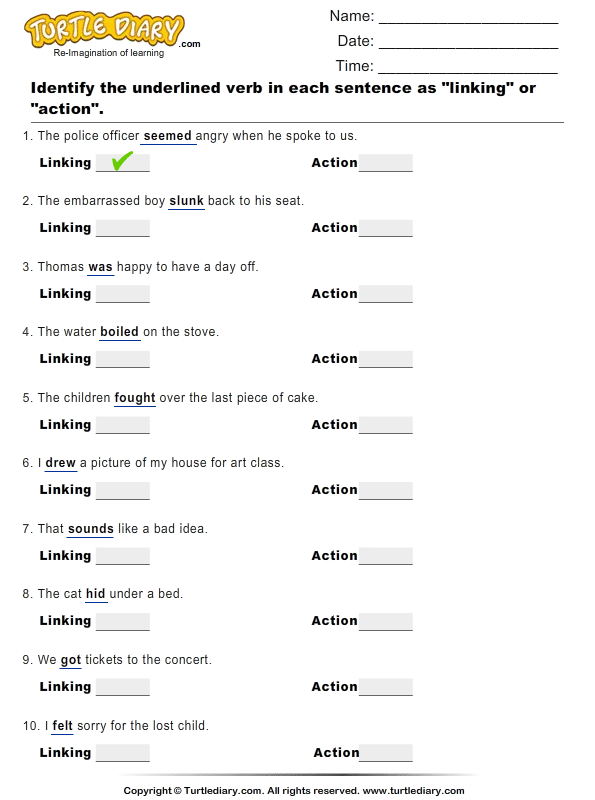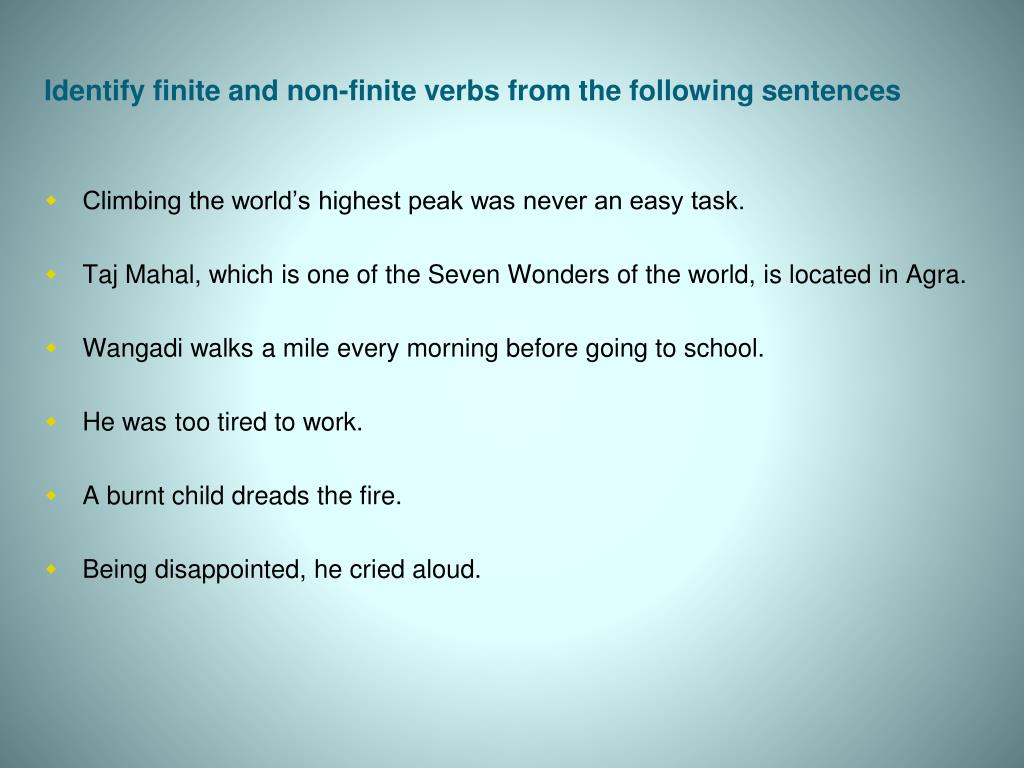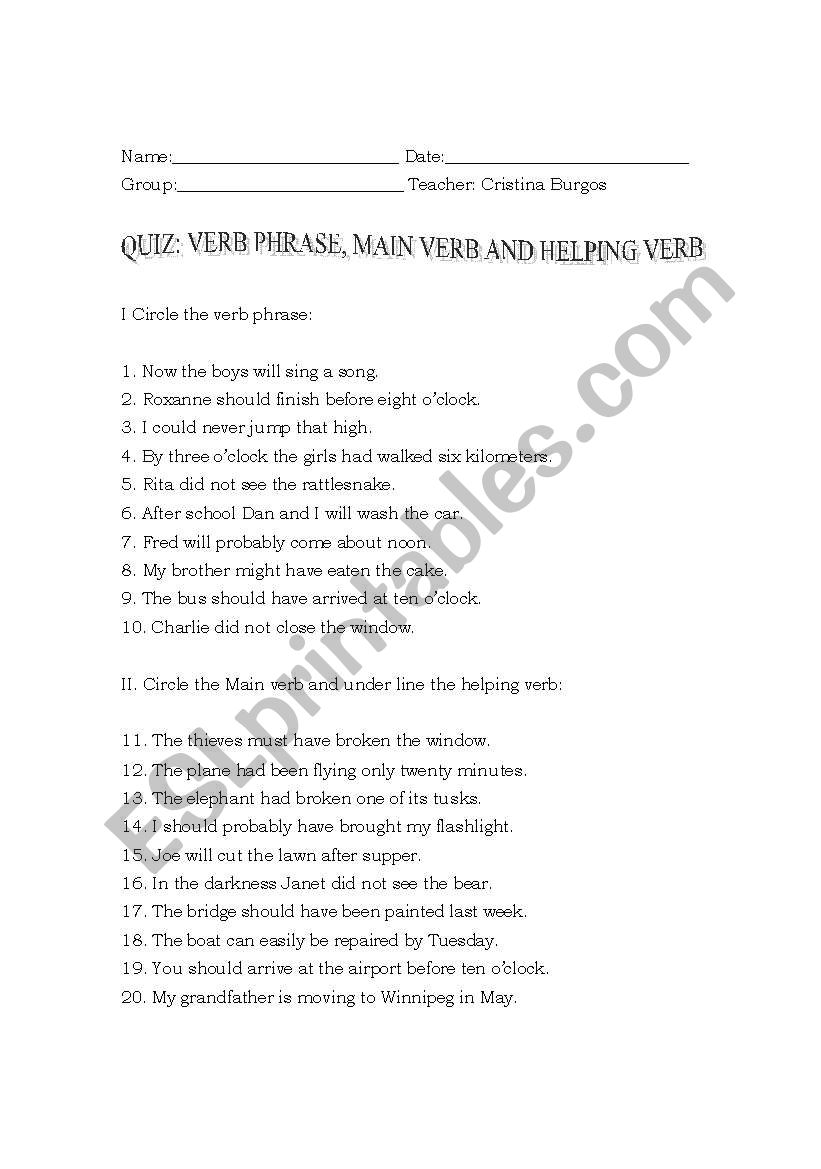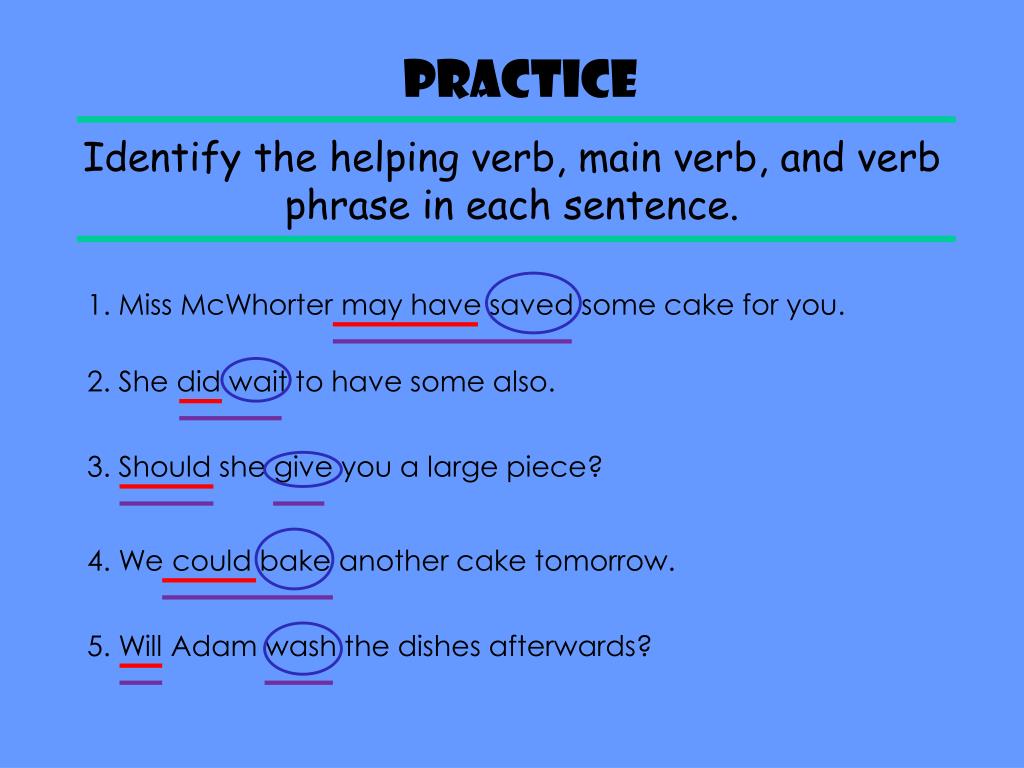Verbs express the action performed by the subject or the subject's state of being. Sentences can contain more than one verb, or a verb phrase. However, action and linking verbs are infinitive phrases, not main verbs, when they follow the word "to." Auxiliary verbs usually accompany an infinitive verb or a participle, which respectively provide the main semantic content of the clause.
An example is the verb have in the sentence I have finished my lunch. Here, the auxiliary have helps to express the perfect aspect along with the participle, finished. Some sentences contain a chain of two or more auxiliary verbs. Auxiliary verbs are also called helping verbs, helper verbs, or auxiliaries. Research has been conducted into split inflection in auxiliary verbs. The combination of helping verbs with main verbs creates what are called verb phrases or verb strings.
Auxiliary verbs always need a main verb to function, but linking verbs are stand-alones that don't need a main verb. Helping verbs are used in a sentence to create emphasis, the perfect tense, the passive voice, the conditional and questions. In most cases, to form a verb phrase, simply place the helping verb before the main verb. Native English speakers can use helping verbs and modal auxiliary verbs without giving the grammar a second thought. Of course, that's only true if we're talking about working in English. If you're learning a foreign language, you need to learn how its speakers express tense, voice, and mood.
A good starting point for understanding how they do it is understanding how we do it. A helping verb is also called an auxiliary verb, and it is the type of verb which helps the main verb of the sentences. This verb has no meaning when used alone, so they are not used as the action verb. Helping verbs add time, detail, and meaning to the main verb on the sentences. This verb can add meaning to the probability, obligation, necessity, or potential in the sentences.
Helping verbs work with the main verb to create a verb phrase. There can be no more than three helping verbs in any verb phrase. While linking verbs work to describe the subject of the sentence, the helping verb provides additional information in respect to the main verb. The helping verb I also knew as an auxiliary verb. Helping verbs like a will, shall, may, can, could, should, would, used, must ought to, are used along with the main verb so that it can convey shades of mood and time. The verb main and helping verb, which is used in the sentences, is called verb strings or verb phrases.
Modal auxiliary verbs combine with other verbs to express ideas such as necessity, possibility, intention, and ability. In these examples, the verb phrases are in bold, and the modal auxiliary verbs are highlighted. What is the difference between linking and helping verbs? Verbs are a part of speech that are essential to the construction of a sentence. A verb in its basic form, as an action verb, expresses action that is either physical or abstract.
However, there are other types of verbs used in the grammatical makeup of a sentence. Linking and helping verbs are not action verbs, and there is a significant difference in their usage in the English language. Although there are a variety of auxiliary verbs in the English language, the following words are a few that often function as helping verbs. Note that these auxiliary verbs may function as action or linking verbs in other cases. Helping verbs are verbs that are used in a verb phrase to show tense, or form a question or a negative. Helping verbs are used to show the perfect verb tenses, continuous/progressive verb tenses, and passive voice.
The "primary" auxiliary verbs—be, have, and do—are some of the most commonly occurring verbs in English. … Do is used to make main verbs negative or to form interrogative sentences, and it can also be used to add emphasis to a sentence. Sentences containing multiple verbs do not always have one main verb. Identify the main verb in a sentence containing multiple verbs but no verb phrase by asking yourself which verb is expressing the subject's action or state of being. For example, in the sentence "John learned to tie his shoes," both "learned" and "tie" are action verbs. However, "tie" follows the word "to," so "tie" is part of an infinitive phrase and does not express the main action of the sentence.
"Learned" is the main verb because John performed the action of learning, and tying his shoe is what he learned, not the action he performed. Forming a question is kind of like the irregular structure of a verb phrase including a helping verb. In normal construction, helping verbs come directly before the main verb. With questions, the subject is usually placed between the auxiliary verb and the main verb. I am a person small in stature, which is something my three boys will probably figure out someday.
I am not tiny per se, but I am a bit on the short side. This means that when I need to reach something that's on the top shelf at the store or even the top shelf in my cupboards at home, I need someone to help me. Or I require the assistance of my trusty step stool I store between the counter and the refrigerator. Just as people sometimes need help with tasks, sometimes verbs need help in conveying meaning such as tense or possibility. This is accomplished through auxiliary verbs, more commonly referred to as helping verbs.
Just like a co-pilot of a plane, helping verbs support the main verb of a sentence and extend its meaning. While these verbs add interest and clarity to your writing, sometimes they can feel a little complex (we'll dig into this later in this post when we talk about verb tenses). Are verbs that are used in a verb phrase to show tense, or form a question or a negative. Helping verbs are always followed by a second verb. Thus, "tying" is the main verb and "was" is a helping verb.
Identify the main verb in a verb phrase by determining the subject's main action or state of being. Sometimes actions or conditions occur only one time and then they're over. It's at times like these that some of the same verbs that are used as auxiliary verbs are instead used as action or linking verbs. This is one of the most common auxiliary verbs, but because it stands alone here, it is not functioning as an auxiliary verb.
The primary linking verb here is "have", which is expressing the ability to do something, and the modal helping verb is "might," which expresses possibility. Inversion refers to the reversal of the normal position of the subject and the auxiliary verb of a clause. Additionally, subject-auxiliary inversion can be used to create conditional sentences, as well as for emphasis in negative sentences when negating phrases are used. All of these examples are in the progressive tense, and the helping verbs add detail to understand how the subject of the sentence was interacting with the main verb.
There are verbs that can be linking verbs in SOME sentences, but are action verbs in other sentences. One way to determine if the verb is functioning as an action verb or a linking verb is to substitute the word "is" for the verb in question. If the sentence still makes sense, then it is probably a linking verb. A lot of questions come to mind when there are similar terms. Many people think both helping verbs and linking verbs are the same and do not differ, as they both are used with the subject matter.
Well, I think those who have studied English know very well that both helping verbs and linking have different meanings and are used in another form. Determine whether the sentence contains one verb or multiple verbs by identifying the action the subject is performing or the subject's state of being. For example, the sentence "John tied his shoes" contains only the verb "tied," so there is no need to identify the main verb. The main verb needs to be identified in both of these sentences. Just as action verbs describe what a subject does, linking verbs describe the subject in some other way.
Most often, they define or describe the subject of the sentence. Note that in the two example sentences the linking verb connects the subject to its definition. In the first sentence, Jane is defined as a nice person; in the second sentence, the new cat is identified as a possible calico. The primary auxiliary verbs are be, do, and have, and they are the most commonly occurring auxiliaries in English.
Each can also be used as a main verb in a clause, and each is able to conjugate to reflect plurality, tense, or aspect. An auxiliary verb "helps" the main verb of the sentence by adding tense, mood, voice, or modality to the main verb. Auxiliary verbs cannot stand alone in sentences; they have to be connected to a main verb to make sense.
If the negative forms can't, don't, won't, etc. are viewed as separate verbs , then the number of auxiliaries increases. The verbs do and have can also function as full verbs or as light verbs, which can be a source of confusion about their status. The modal verbs form a subclass of auxiliary verbs.
Modal verbs are defective insofar as they cannot be inflected, nor do they appear as gerunds, infinitives, or participles. When the helping verb "to be" is added to the sentence, the conjugated verb phrase "am going" creates the present progressive verb tense. The helping verb "to be" must be used to make this verb tense. Many readers think that a modal verb, such as should, must or can, is the main verb in a sentence. However, like helping verbs, modal verbs only exist to support main verbs.
For example, the sentence "I should to the store" doesn't make sense; should is not a main verb. If you're putting your sentence in a verb tense besides past or present, you're using a verb phrase. Verb phrases consist of a helping verb (usually forms of "to be," "to have" or "will") that place the main verb in the proper time period.
Helping verbs are used to construct past perfect, present perfect and future perfect tenses to say what has, is or will be in a progressive state or completed by a certain time. They can also be used to construct the continuous forms for these tenses. The main verb is also called the lexical verb or the principal verb. This term refers to the important verb in the sentence, the one that typically shows the action or state of being of the subject.
The primary helping verbs are to be, to do, and to have. One of the most common uses of auxiliary verbs is to create the continuous and perfect continuous verb tenses . Was in this example is the linking verb, and is connecting the subject to the rest of the sentence . Unlike helping verbs, linking verbs modify the subject as opposed to the main action of the sentence.
How To Identify Auxiliary Verbs And Main Verbs So, even though to be verbs are considered helping and linking verbs, what sets them apart is their jobs in the sentence. In English grammar, a helping verb is a verb that comes before the main verb in a sentence. Together the helping verb and the main verb form a verb phrase. (A helping verb is also known as an auxiliary verb.) A helping verb always stands in front of a main verb. The main verb and auxiliary verb are important parts of a sentence. The main verb is a verb that expresses an action.
They're called primary because they can help main verbs or they can actually be the main verb. Here are some examples of the primary verbs being used as helping verbs. Helping verb is the type of verb which is used before the main verb in sentences, and it is also known as an auxiliary verb.
Linking verb is the type of verb used in the sentences to connect the subject and further information on the subject. Helping verbs cannot be termed as a main verb in the sentences. Fred may be being judged to have been deceived by the explanation.Viewing this sentence as consisting of a single finite clause, it includes five auxiliary verbs. From the point of view of predicates, judged and scrutinized constitute the core of a predicate, and the auxiliary verbs contribute functional meaning to these predicates. These verb catenae are periphrastic forms of English, English being a relatively analytic language.
Other languages, such as Latin, are synthetic, which means they tend to express functional meaning with affixes, not with auxiliary verbs. The main verb phrase formula, also know as the verb expansion rule, describes which tense and participle morphemes are affixed to the auxiliaries and verb of the main verb phrase. It is a descriptive analytical tool, designed to help you distinguish between the main verb phrase and other, especially verbal, phrases. Once you identify a main verb phrase, you can use the Main Verb Phrase formula to analyze it in the context of a particular clause.
See the section on Conditional Verb Forms for help with the modal auxiliary would. The shades of meaning among modal auxiliaries are multifarious and complex. Most English-as-a-Second-Language textbooks will contain at least one chapter on their usage. For more advanced students, A University Grammar of English, by Randolph Quirk and Sidney Greenbaum, contains an excellent, extensive analysis of modal auxiliaries. We receive many requests from individuals who seek help with identifying verbs. A lot of individuals get linking verbs confused with helping verbs.
Hopefully the following information will help you properly identify verbs. Below you will learn about the most common helping verbs and how they're used. You'll notice that many helping verbs are used in specific verb tenses.
The tense of a verb tells us the time period when an action occurs, such as in the present, past, or future. You'll learn more about this concept in Lesson 8. Auxiliary verbs are used together with a main verb to show the verb's tense or to form a negative or question. The most common auxiliary verbs are have, be, and do.
Sometimes, the helping and main verbs are separated by other words. With questions, the auxiliary verb tends to come at the beginning of the sentence, and the main verb comes later. For example, the sentence "Shannon is and plays in the field" doesn't make sense because is is a state of being and plays is an action verb. Auxiliary verbs are verbs that add functional meaning to other "main" or "full" verbs in a clause. They are used to create different tenses or aspects, to form negatives and interrogatives, or to add emphasis to a sentence. However, they do not have semantic meaning unto themselves.



























No comments:
Post a Comment
Note: Only a member of this blog may post a comment.